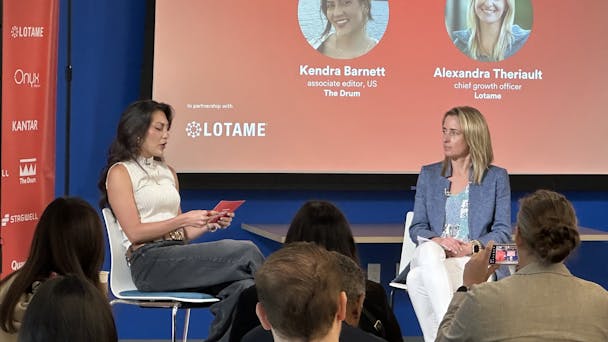Why advertisers need to sow data fields outside walled gardens
With the industry at a cookie crossroads, how can brands bridge the addressability gap by cultivating new data collaboration solutions? We sat down with Alex Theriault, Lotame’s chief growth officer at The Drum Live in New York City, to find out more.

The Drum's Kendra Barnett and Lotame's Alex Theriault in action at The Drum Live New York / The Drum
As the cookie countdown continues, 66% of all digital ad spend in 2024 is expected to be concentrated within walled gardens – but 66% of consumer time is spent outside of these spaces.
“There is a ton of competition within the walled gardens for those eyeballs and for that attention. And there’s all this green field outside of it, with no clear playbook,” says Theriault. Not only that but, for those who are managing to harvest first-party data within, or outside of walled gardens, it’s not enough, she adds: “It only uncovers so much about who your customers are.”
So, what’s the answer? What is the new data planting guide?
Collaborate to sow new data seeds
In a world where cookies and signals of all kinds are rapidly disappearing on the open web, data collaboration is increasingly crucial. That’s when first-, second- and third-party data sets are brought together within an organization, or, more usually, with external partners, to deepen the data pool.
The result? Better insights and decision-making capabilities across the board, says Theriault, including “better analysis, better campaign planning, better measurement, and activation at scale.”
Encourage growth with a range of partners
In data collaboration’s simplest form, ‘clean room’ platforms such as Snowflake and AWS are ideal for joining together different data sets such as a brand’s first-party data with a publisher’s first-party data.
But some clean rooms focus on deterministic data alone, which means that brands must have data tied to an email or some other deterministic identifier. What about unknown audiences? What about those valuable consumers who add products to their cart but then abandon it? The answer is for advertisers to team up with a range of partners, who can unlock different levels of data insights that enable them to move beyond simple, privacy-safe ID resolutions.
When it comes to choosing partners, in general, Theriault advises brands to delve deep and “ask more of your vendors” via educational presentations and resources as “the good ones will bubble to the top.” More specifically, understand more about their ability to go further than collecting data insights, asking them “how do I take this information that I've learned and put it into action, put it into a DSP and an SSP, depending on the strategy?” she adds.
Data collaboration in action
To illustrate how data collaboration can enhance a brand’s understanding of their audiences, Theriault shared two best practice examples.
The first was from RE/MAX, a US real estate brand teeming with first-party data, and its collaboration with Advance Local, one of the largest local media brands in the US. A real estate focused contextual advertising approach would have had limited effect due to a lack of relevant media inventory in a competitive real estate market. But combining RE/MAX’s lower funnel data set of those likely to buy a house in the next 30 days with Advance Local’s first-party data set uncovered a whole new swathe of relevant consumer behaviors and demographics which would better inform contextual activation.
Her second example came from an egg brand which didn’t have much first-party data and was advertising in competitive recipe and food spaces. Working with data panel partners meant the brand could deploy a survey to create data that represented their customer. This unlocked the insight that a high concentration of parents was buying their product, which led to the brand buying more parent content inventory and pushing lookalike audiences into Meta.
Making data bloom: a 3-step approach
Theriault shared three ways in which advertisers can optimize their data collaboration strategies to bridge their impending addressability gap:
-
Generate and unify: generate as much first-party data as possible, perhaps via new strategies, and combine it into a single source of truth – potentially within a customer data or data collaboration platform, likely extending beyond a CRM tool.
-
Extend and enrich: extract customer insights from first-party data through data collaboration, finding that same user across their different connected devices, and different domains. Theriault advises brands to “work with trusted partners, and make sure that you have a full view of who your customer is.”
-
Test and deploy: find new ways to generate and activate data without relying solely on third-party cookies, including universal IDs or alternative approaches such as programmatic curation. This involves strategically selecting and managing high-quality ad inventory, often through partnerships with publishers (via SSPs), and combining it with audience data to deliver more targeted and effective advertising.
For more information on how advertisers can use data collaboration to harvest data for innovation and growth, watch our chat with Lotame’s Alex Theriault on The Drum TV here.
Content created with:

Lotame
Lotame is a technology company that makes data smarter, faster, and easier to use for digital marketers. Our end-to-end data collaboration platform Spherical empowers...
Find out more
